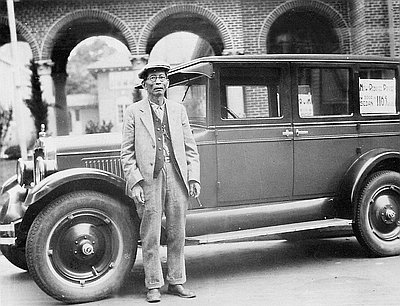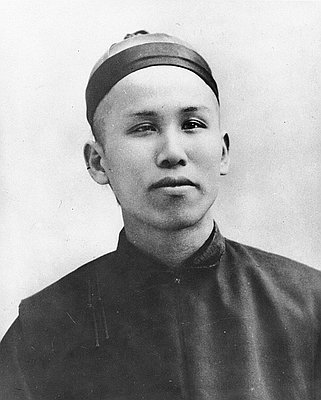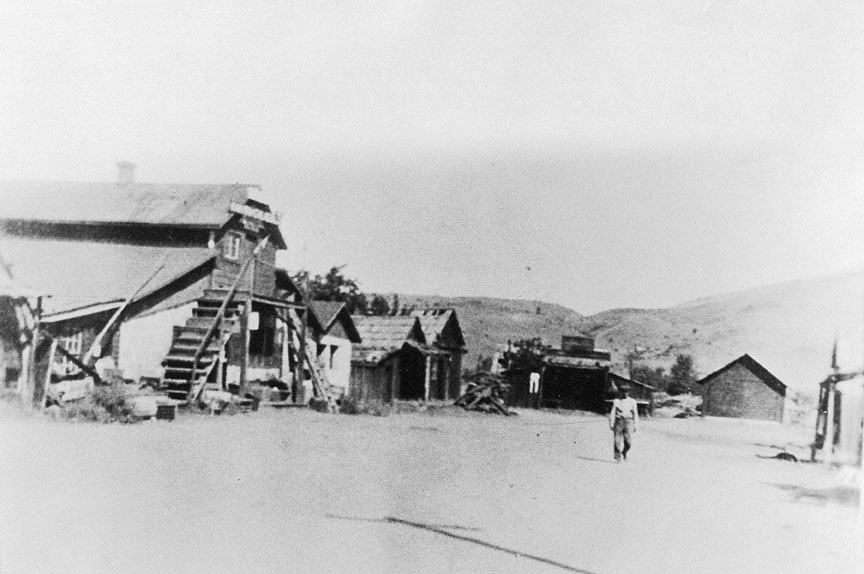- Catalog No. —
- OrHi 53764
- Date —
- 1909
- Era —
- 1881-1920 (Industrialization and Progressive Reform)
- Themes —
- Environment and Natural Resources, Geography and Places, Race, Ethnicity, and Nationality
- Credits —
- Oregon Historical Society
- Regions —
- Northeast
- Author —
- Unknown
Kam Wah Chung, John Day, 1909
This photograph shows John Day’s Chinatown in 1909. The large structure at the left is the Kam Wah Chung building, which served as Chinatown’s social center for several decades.
Chinese miners probably settled in John Day soon after the establishment of the town in the early 1860s, though the largest Chinese settlement in eastern Oregon was in Canyon City until 1885. In February of that year Canyon City’s Chinatown was burned down, probably by arsonists. Local authorities refused to let the Chinese rebuild, so many moved down the creek to John Day, where they added to the town’s established Chinese community. During its peak, John Day had the largest Chinese community in eastern Oregon, numbering between five and six hundred residents.
John Day’s Chinatown centered on the Kam Wah Chung building, a stone structure probably built in the late 1860s as a trading post and temporary fort along The Dalles Military Road. It was purchased in 1887 by Ing “Doc” Hay and Lung On, Chinese immigrants who opened a general store in September 1888. The Kam Wah Chung building also served as a social center and hiring hall for eastern Oregon’s Chinese community.
During the nineteenth century, most Chinese immigrants in the inland Northwest were gold miners. Minnie Ford, born in Canyon City in 1868, told a Works Progress Administration researcher in 1939 that “the mining they did was quite different than the white man’s. Usually, the Chinese washed the gravel which the white man had thrown out as waste. They made a good deal of money by using the tailings left by the whites.” She commented that “the Chinese were an honest, industrious race of people. Most everyone in Canyon had at least one working for him. Too, the poor fellows were often the source of much amusement, and the butt of many a practical joke in this rough and ready mining camp.”
Grant County’s Chinese population peaked in the 1870s and 1880s. Although the U.S. Census lists over 900 Chinese residents of the county in 1870 and 1880, the actual number was probably twice that. The Chinese population began to decline rapidly in the 1890s, and by 1910, fewer than one hundred remained. Mining opportunities had mostly dried up and the economy of the county had shifted to livestock and agriculture.
A handful of Chinese stayed in John Day, however, including Ing Hay and Lung On, who operated Kam Wah Chung & Co. until the 1940s. They became well-known members of the community, respected by both whites and Chinese. The Kam Wah Chung building was listed in the National Register of Historic Places in 1973 and today operates as a museum.
Further Reading:
Barlow, Jeffrey G. and Christine Richardson. China Doctor of John Day. Portland, Oreg., 1979.
McCunn, Ruthanne Lum. Chinese American Portraits: Personal Histories, 1828-1988. San Francisco, Calif., 1988.
Written by Cain Allen, © Oregon Historical Society, 2005.
Related Historical Records
-
Lung On
This photograph shows John Day merchant Lung On standing in front of a four-door sedan that he was selling. It was taken in 1927 by Oregon Journal photographer …

-
Ing 'Doc' Hay, c. 1890
This portrait of the Chinese doctor Ing Hay was taken when he was nineteen years old. Doc Hay, as he was best known, was a prominent medical practitioner …

